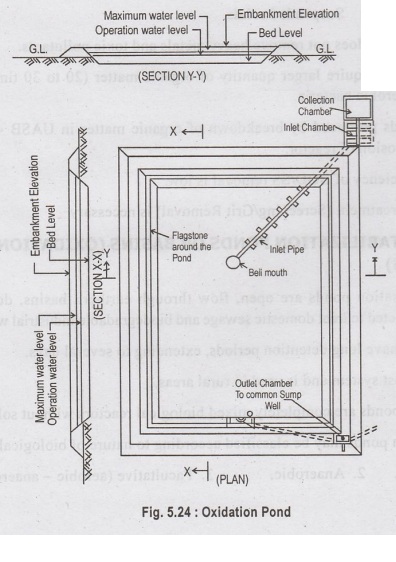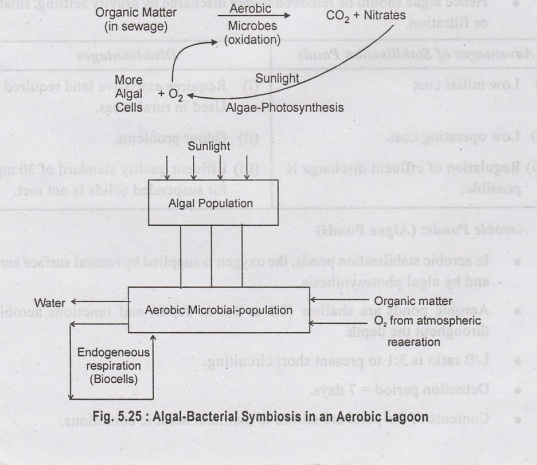Water Supply And Wastewater Engineering: Unit V: Sewage Treatment And Disposal
Waste Stabilization Ponds or Basins (Oxidation Ponds/Lagoons)
Features, Construction, Advantages, Disadvantages
Stabilisation ponds are open, flow through earthern basins, designed and constructed to treat domestic sewage and biodegradable industrial waste waters.
WASTE
STABILIZATION PONDS OR BASINS (OXIDATION PONDS/ LAGOONS)
•
Stabilisation ponds are open, flow through earthern basins, designed and
constructed to treat domestic sewage and biodegradable industrial waste waters.
•
WSBS have long detention periods, extending to several days.
•
Low cost system and is used in rural areas.
•
These ponds are completely mixed biological reactors without solids retur
Stabilisation
ponds may be classified according to nature of biological activity: 1. Aerobic,
2. Anaerobic, 3. Facultative (aerobic - anaerobic).
Construction:
•
These are earthern pits made of impervious soil (clay).
•
Lining is provided to prevent seepage of ground water.
•
The depth varies from 1 m to 1.8 m.
•
The walls of the pond are sloped and the topwidth varies from 2.5 to 3 m.
•
Minimum free board of 0.6 m. is provided.
•
Influent enters at the centre of the
pond and the effluent overflows in a
corner.
•
The detention time is usually 2-6 weeks.
•
In the stabilisation ponds, microbial plants like algae, protozoans, bacteria
and rotifers grow and metabolize the organic wastes in sewage.

•
The sewage contains organic matter that provides food to the microbial Obra
population. The microbes stabilize the organic matter (oxidation) into CO2,
помо nitrates and nutrients. The nutrients released are taken by the algal
population Isidoroim and in return it releases oxygen by photosynthesis.
•
The algae (microscopic plants) which grows in the presence of sunlight, produce
oxygen by the action of photosynthesis and this oxygen is utilised by the
bacteria for oxidising the waste organic matter. This process is known as
"bacterial-algal symbiosis" and results in complete stabilization of
organic wastes.
•
When tank depth is greater, lack of mixing and aeration occurs, which results
in anaerobic digestion of the settled solids in the tank bottom.
•
The dissolved oxygen in pond water is high during afternoon due to the release
of oxygen by algae in the presence of sunlight.
•
BOD reduction is above 95% (in summer) but as algae contribute to suspended
solids/BOD, the effluent standard BOD < 30 mg/l cannot be met.
•
Algae contribute about 50-70 mg/l of SS/BOD.
•
Algae is a serious problem in lagoon treatment.
•
Hence algae should be removed before discharge by gravity settling, floatation
or filtration.

Advantages of Stabilisation Ponds
(i)
Low initial cost
(ii)
Low operating cost.
(iii) Regulation of effluent discharge is possible.
Disadvantages
(i)
Requires extensive land required laertnyeol esgl Used in rural areas.
(ii)
Odour problems.
(iii)
Effluent quality standard of 30 mg/l for suspended solids is not met.
(1) Aerobic ponds
(Algae Ponds)
•
In aerobic stabilization ponds, the oxygen is supplied by natural surface
aeration and by algal photosynthesis.
•
Aerobic ponds are shallow (0.5 to 1.2 m depth) and functions aerobically
throughout the depth.
•
L/B ratio is 3:1 to present short circuiting.
•
Detention period = 7 days.
•
Contents of the pond are stirred to maintain aerobic conditions.
The
daily sewage flow containing organic material provides food to the aerobic
microbial population which stabilises/oxidises the organic matter into nitrates
and CO2. The CO2 and nitrates so formed are used by algal population for growth
and production of new algal cells, thereby releasing oxygen. This oxygen in
turn is used by microbial population for oxidation of organic waste. This is
called bacterial-algal symbiosis.
Oxygen transfer depends on:
(i) Lagoon surface
area to volume.
Larger
the ratio, better will be the O2 diffusion into the lagoon. ailuast
doidwa
(ii) Temperature of
lagoon.
Greater
solubility of O, in water and hence greater diffusion rate at lower
temperature.
(iii) Turbulence.
Generally
provided by the wave action.
(iv) Bacterial oxygen
uptake rate.
The
faster the microbes consume D.O, the greater will be the rate at which oxygen
is replenished.

(2) Anaerobic Ponds:
The
entire depth of pond is in anaerobic condition. The anaerobic decomposition takes
place in two steps.
Step 1:
Decomposition of dissolved organic waste by acid-producing bacteria into
organic acids (such as acetic, butyric acid) and new anaerobic microbial cells.
Step 2:
Decomposition of these acids into end products methane CH4, carbon
dioxide CO2 and water by methane producing bacteria.
→
The black colour of lagoon indicates that the lagoon is functioning properly.
→
Process releases H2S septic odours and the effluent is only partially purified.

The
abnoxious odours are due to the reduction of sulphate compounds into hydrogen
sulphide (H2S) by acid producing bacteria. The solution is to limit the
concentration of sulphate in the influent.

•
Anaerobic ponds require less surface area than aerobic ponds (1/30-th)
•
Pond depth is 2.5 m to 5 m for improved heat retention.
•
L/B = 2:1; Detention is 2 to 5 days.
•
BOD reduction is 65 to 85% during summer and 45% to 65% during winter.
•
Sludge is accumulated for 10 years.
•
Anaerobic ponds are used for the treatment of strong industrial wastes and has
limited use in sewage treatment.
(3) Facultative Ponds
(Oxidation Ponds)
•
Combination of aerobic and anaerobic ponds.
•
Constructed of Intermediate depth = 1 to 1.5 m.
Facultative
ponds consists of three zones:
(i)
Aerobic zone at the top.
(ii)
Anaerobic zone at the bottom.
(iii)
Facultative zone between aerobic zone and anaerobic zone.

•
The aerobic zone is similar to aerobic ponds (Bacterial Algal Symbosis). To no
In the top layers, Algae grows and utilize CO, during day light for
photosynthesis and liberate O2 and maintains the aerobic conditions.
•
The aerobic conditions promotes the oxidation of organic waste matter by
aerobic bacteria.
•
In facultative zone, the facultative bacteria oxidize the incoming organic
waste as well as products of anaerobic decomposition.
•
Greater depths prevent mixing and settled solids remain in the bottom.
•
When sewage enters the pond, the suspended and colloidal matter settles at the
bottom and undergoes Anaerobic Fermentation (Methane Fermentation) and
liberates Methane -0.25 g of methane is liberated for 1 g of BODu

Aerated
Lagoons:
•
Used when wind mixing and oxygenation by algae is not sufficient and when
stabilisation ponds are overloaded with industrial waste at reduced
temperatures.
•
Aerated lagoons are intermediate between Oxidation Ponds and ASP.
•
The oxygenation is provided by mechanical surface aerators installed on rafts
or floats.
•
Greater Depth of about 2.5 m to 4 m is provided.
• Land
required is less.
•
Smaller Detention Time
Types
→ (1) Complete Mixed
(2) Partially Mixed
Type
→ Aerobic Aerated Lagoons
Facultative
Aerated Lagoon.
(1) Complete Mix
Aerated Lagoon.
• Greater aeration is provided to keep solids in suspension to maintain aerobic conditions.
• Similar to ASP but without recirculation.
•
First unit provided with surface aerators to maintain the solids in suspension.
•
Second unit is used as a settling tank which removes the suspended solids.
SS
concentration - 60 to 300 mg/l.
Detention
- 2 to 10 days.
O2required
- 0.7 to 1.3 kg/kg BOD5
BOD
removal - 75 to 85%.
(2) Partially Mixed
System.
•
These are operated at low rate of
aeration which is not suffiicient to keep all the solids in suspension.
Therefore, the solids tend to settle down.
•
Only the top layers remain aerobic.
•
Large portion of incoming solids in
sewage settle at the tank bottom which boobs undergoes anaerobic decomposition.
•
Effluent produced is more stable.
Settled
Sludge (SS) Concentration - 30 to 150 mg/l.
Detention Time - 3 to 5 days.
O2
required for oxygenation - 0.8 kg/kg BOD, removed.
BOD
removal - 75 to 90%.
•
The settled sludge needs to be removed after few years.
Design Criteria for Oxidation
Ponds:
Depth
- 1 m to 1.8 m
Detention
- 2 to 6 weeks - depends on sunlight and temperature.
-
7 to 42 days.
Surface
area - Based on organic loading - 300 to 150 kg/ha/d (India).
Area
= 0.5 to 1 hectare

Advantages
of Oxidation Ponds
•
Cheap and low cost process.
•
Suitable for small towns and cities.
•
Suitable for hot dry country (India).
• Low maintenance.
• No skilled supervision required.
• Flexible for fluctuations in flow and organic
loading.
Disadvantages of Oxidation Ponds
• Mosquito Breeding.
• Algal growth.
• Bad Odours.
Water Supply And Wastewater Engineering: Unit V: Sewage Treatment And Disposal : Tag: : Features, Construction, Advantages, Disadvantages - Waste Stabilization Ponds or Basins (Oxidation Ponds/Lagoons)
Related Topics
Related Subjects
Water Supply and Wastewater Engineering
CE3303 3rd Semester Civil Dept 2021 Regulation | Tag: 3rd Semester Civil Dept 2021 Regulation
